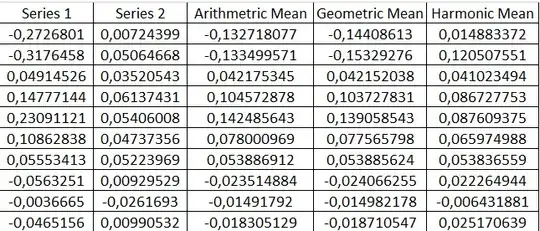I'm searching for a nice mean (or average) for negative numbers that gives less weight to high (absolut) outliers (I don't have enough values to use median). Obviously the way to go for positive values is the geometric mean but this is not working (without transformation) for negative values. To be more precise I a series with negative and positive values ranging from $[-1, 1]$.
Looking for some alternatives I found:
- Harmonic Mean
- adding x (for me this is 1) to all values, using the geometric mean and subtract x again (Geometric mean on negative numbers - work-around)
Using these methods and comparing them to the arithmetic mean I get:
Both the harmonic Mean and the geometric mean are larger than the arithmetic mean (in absolute terms). Is there another method I can use or do I make a mistake?
Thank you.
p.s. I was looking at the geometric mean again and I used $x=100000$ instead of $x=1$ and now my results for the geometric mean are very close to the arithmetic which is mentioned in the link above. So this method is not really a workaround but a dilluted method for the arithmetic mean.
